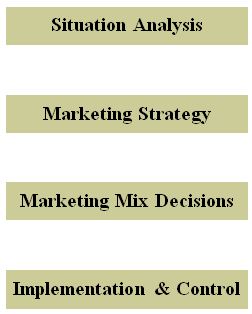Under the marketing concept, the firm must find a way to discover unfulfilled customer needs and bring to market products that satisfy those needs. The process of doing so can be modeled in a sequence of steps: the situation is analyzed to identify opportunities, the strategy is formulated for a value proposition, tactical decisions are made, the plan is implemented and the results are monitored.
The Marketing Process
I) SITUATION ANALYSIS
A thorough analysis of the situation in which the firm finds itself serves as the basis for identifying opportunities to satisfy unfulfilled customer needs. In addition to identifying the customer needs, the firm must understand its own capabilities and the environment in which it is operating.
The situation analysis thus can be viewed in terms an analysis of the external environment and an internal analysis of the firm itself.
The situation analysis should include past, present, and future aspects. It should include a history outlining how the situation evolved to its present state, and an analysis of trends in order to forecast where it is going.
If the situation analysis reveals gaps between what consumers want and what currently is offered to them, then there may be opportunities to introduce products to better satisfy those consumers. Hence, the situation analysis should yield a summary of problems and opportunities. From this summary, the firm can match its own capabilities with the opportunities in order to satisfy customer needs better than the competition.
The two common frameworks used to do the situation analysis:
- PEST analysis – for macro-environmental political, economic, societal, and technological factors. A PEST analysis can be used as the “climate” portion of the 5 C framework.
- SWOT analysis – strengths, weaknesses, opportunities, and threats – for the internal and external situation. A SWOT analysis can be used to condense the situation analysis into a listing of the most relevant problems and opportunities and to assess how well the firm is equipped to deal with them.
II) MARKETING STRATEGY
Once the best opportunity to satisfy unfulfilled customer needs is identified, a strategic plan for pursuing the opportunity can be developed. Market research will provide specific market information that will permit the firm to select the target market segment and optimally position the offering within that segment. The result is a value proposition to the target market. The marketing strategy then involves:
- Segmentation
- Targeting (target market selection)
- Positioning the product within the target market
- Value proposition to the target market
III) MARKETING MIX DECISIONS
Detailed tactical decisions then are made for the controllable parameters of the marketing mix. The action items include:
- Product development – specifying, designing, and producing the first units of the product.
- Pricing decisions
- Distribution contracts
- Promotional campaign development
IV) IMPLEMENTATION AND CONTROL
At this point in the process, the marketing plan has been developed and the product has been launched. Given that few environments are static, the results of the marketing effort should be monitored closely. As the market changes, the marketing mix can be adjusted to accommodate the changes. Often, small changes in consumer wants can addressed by changing the advertising message. As the changes become more significant, a product redesign or an entirely new product may be needed. The marketing process does not end with implementation – continual monitoring and adaptation is needed to fulfill customer needs consistently over the long-term.
Before selling a product or service, it’s important to know the market that you will be entering into. Research includes finding out what potential customers need, want and don’t want, and why. Your goal is to build a demographic profile of your customers. A research or business library can prove helpful for studying the manners in which other small businesses have approached their target audiences. You can then take a similar approach, adding your own creativity and the particular benefits of your products or services.
Surveys, questionnaires, and focus groups are three among the many ways to obtain original data on potential customers. You can also get basic information when a customer calls for your services, visits your facility, or browses your web site. When customers make a purchase, or any kind of inquiry, you can find out where they heard about your business. In this manner you can better plan, and track, your marketing efforts.

